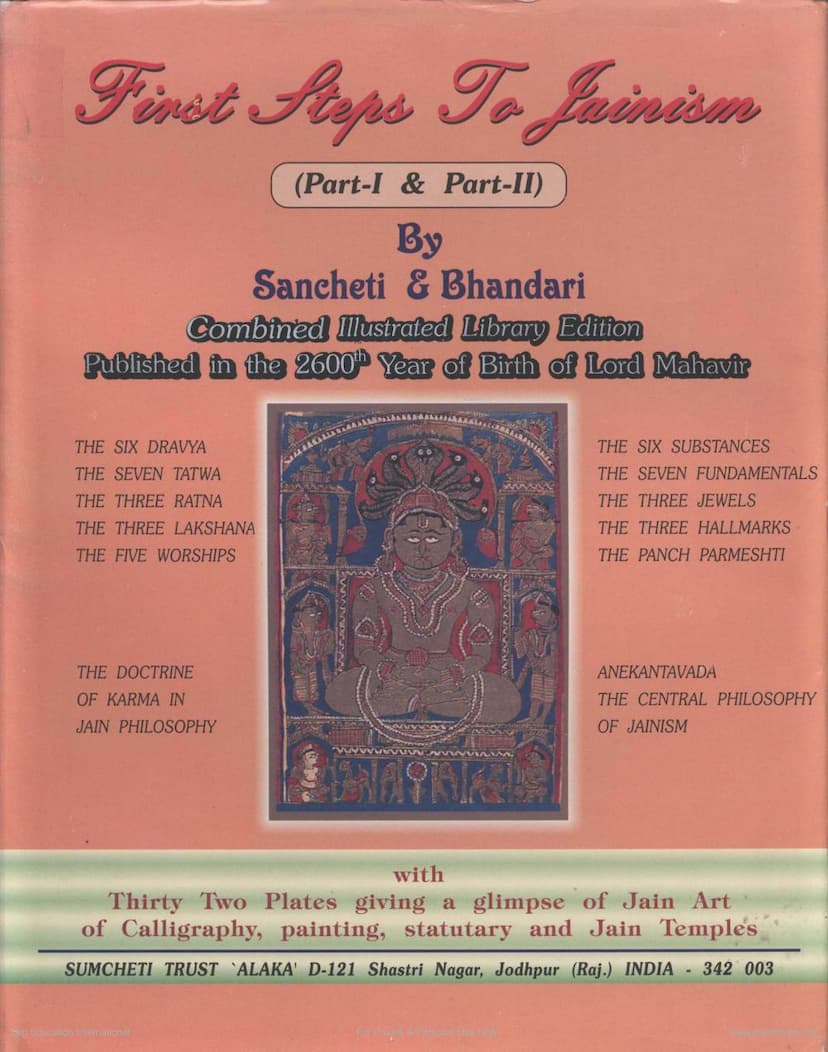First Steps To Jainism Part 1
Added to library: September 1, 2025

Summary
"First Steps to Jainism, Part 1" by Sancheti Asolal and Manakmal Bhandari, published by Sancheti Trust Jodhpur, serves as a foundational introduction to Jainism for the general reader. The book aims to present the core ethical, metaphysical, and philosophical tenets of Jainism in simple language, making it accessible to those unfamiliar with the religion.
Key Themes and Content:
The book is structured into five "steps," each covering a fundamental aspect of Jainism:
-
Groundwork: This introductory chapter provides a broad overview of Jainism, explaining its origins, the meaning of "Jina" and "Jain," the concept of Tirthankaras (prophets), and the historical presence and influence of Jainism in India. It highlights Jainism's emphasis on non-violence, self-control, and penance, and its contribution to Indian culture, particularly vegetarianism. It also touches upon the distinction between Vedic and Shramanic traditions and the Jain rejection of a creator God, emphasizing self-action and the soul's potential for self-liberation.
-
Step One: The Universe - Six Substances (The Dravya): This chapter delves into Jain metaphysics, presenting the Jain understanding of the universe as an uncreated, eternal entity. It introduces the six fundamental substances that constitute the universe:
- Living beings (Jeeva): The conscious soul, eternal, formless, with inherent potential for perfection.
- Matter (Pudgal): Non-living, form-possessing substance, the smallest indivisible particle being Parmanu.
- Time (Kaal): Eternal, non-material, with a distinctive quality of passage causing modification.
- Space (Akash): Accommodates other substances and extends beyond the universe.
- Medium of Motion (Dharmastikaya): Facilitates movement.
- Medium of Rest (Adharmastikaya): Facilitates stillness. The chapter explains the universe's finite spatial dimension enclosed within infinite space and provides a conceptual understanding of its vastness and constituents, emphasizing the soul's central role.
-
Step Two: The Seven Fundamentals (The Tatva): Building on the concept of the soul and matter, this chapter details the process of their interaction, which forms the core of Jain philosophy. The seven fundamentals are:
- Living Soul (Jiva): Reiterates the nature of the soul.
- Non-living Matter (Ajiva): Refers to the collective of matter, space, time, medium of motion, and medium of rest.
- Influx (Asrava): The inflow of karmic matter into the soul due to activities.
- Bondage (Bandha): The attachment of matter to the soul.
- Prevention (Samvara): Stopping the influx of karma.
- Separation (Nirjara): Shedding of accumulated karma.
- Liberation (Moksha): The ultimate freedom of the soul from all karmic bondage. This step explains the mechanism of karma as subtle matter attaching to the soul and influencing its journey through life and death.
-
Step Three: The Three Jewels (The Ratna): This chapter outlines the practical path to liberation, known as the Three Jewels:
- Right Vision (Samayag Darshan): Correct perception of reality, including the belief in the true nature of the universe, the seven fundamentals, and true prophets, scriptures, and preceptors.
- Right Knowledge (Samyag Gyan): Accurate and complete knowledge of reality, leading to spiritual development.
- Right Conduct (Samayag Charitra): Ethical behavior, including self-restraint, non-violence, and penance, which involves adherence to vows and disciplines. These three jewels are presented as the "highway to liberation."
-
Step Four: The Three Hallmarks (The Lakshana): This step distills the essence of Jain ethics into three distinct hallmarks:
- Non-violence (Ahimsa): The foundational principle, extending to all living beings and even inanimate objects in its broader implications, emphasizing the sanctity of life.
- Self-control (Samyam): Control over body, mind, and speech, managing passions and desires.
- Penance (Tapa): Austerities and self-discipline to shed karmic bondage and control the senses. These hallmarks are presented as the defining characteristics of Jainism and its way of life.
-
Step Five: The Five Worships (The Panch Parmeshthi): This chapter explains Jain practices of veneration and prayer, focusing on the Namaskar mantra. It clarifies that worship in Jainism is directed towards the qualities of the five supreme beings (Panch Parmeshthi), rather than a creator God. These five are:
- Arihantas: Omniscient beings who have conquered internal enemies (passions) and are free from major karmic bondage while still embodied.
- Siddhas: Liberated souls who have completely destroyed all karma and are bodiless.
- Acharyas: Heads of the monastic order, guiding monks, nuns, and laity.
- Upadhyays: Spiritual teachers responsible for disseminating scriptural knowledge.
- Saints (Sadhu/Muni): Ascetics who have renounced worldly life and practice austerities. The chapter highlights the universality and impersonal nature of this worship, aimed at acquiring the qualities of these revered beings.
Overall, "First Steps to Jainism, Part 1" aims to provide a clear, concise, and positive introduction to the fundamental principles of Jainism, emphasizing its rational approach, ethical teachings, and the path to spiritual liberation through self-effort. The book also includes illustrative plates of Jain art, providing a visual dimension to the text.
Part 2 of the book, not fully detailed here, covers more advanced topics like the Doctrine of Karma, Anekantavada, Gunasthana, and the Five Bodies, further deepening the reader's understanding of Jain philosophy.